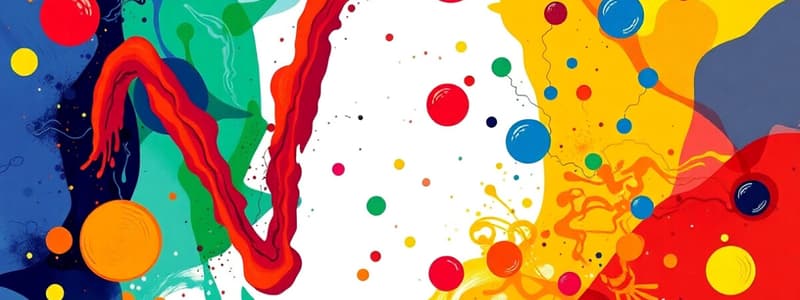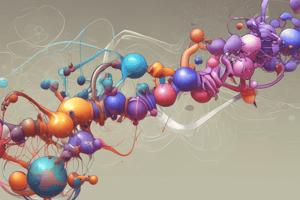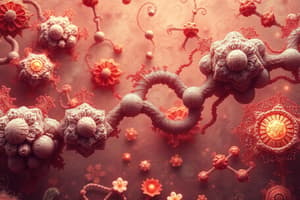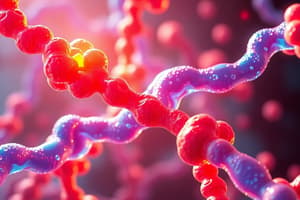Podcast
Questions and Answers
Which of the following is NOT a characteristic of enzymes?
Which of the following is NOT a characteristic of enzymes?
- They lower the free energy of the transition state.
- They accelerate reaction rates.
- They influence the equilibrium of reactions. (correct)
- They bind substrate molecules at their active sites.
An enzyme requires a coenzyme for its activity. Without the coenzyme, the enzyme is referred to as:
An enzyme requires a coenzyme for its activity. Without the coenzyme, the enzyme is referred to as:
- an inhibitor
- a catalyst
- an apoenzyme (correct)
- a holoenzyme
Transition state analogs are effective competitive inhibitors because:
Transition state analogs are effective competitive inhibitors because:
- they alter the enzyme's structure allosterically.
- they bind irreversibly to the enzyme.
- they bind to the active site with very high affinity. (correct)
- they have a very low affinity for the active site.
Which of the following is an example of covalent catalysis?
Which of the following is an example of covalent catalysis?
In enzyme kinetics, what does the Michaelis-Menten constant (Km) represent?
In enzyme kinetics, what does the Michaelis-Menten constant (Km) represent?
How does an uncompetitive inhibitor affect the $V_{max}$ and $K_m$ of an enzymatic reaction?
How does an uncompetitive inhibitor affect the $V_{max}$ and $K_m$ of an enzymatic reaction?
Which amino acid residue is commonly involved in acid-base catalysis by enzymes?
Which amino acid residue is commonly involved in acid-base catalysis by enzymes?
What is the role of histidine in the mechanism of action of serine proteases?
What is the role of histidine in the mechanism of action of serine proteases?
Which of the following best describes reciprocal regulation in the context of metabolic pathways?
Which of the following best describes reciprocal regulation in the context of metabolic pathways?
Which statement is true regarding allosteric enzymes?
Which statement is true regarding allosteric enzymes?
In glycolysis, how does ADP function in the regulation of phosphofructokinase-1 (PFK1)?
In glycolysis, how does ADP function in the regulation of phosphofructokinase-1 (PFK1)?
Which of the following is NOT a characteristic of carbohydrates?
Which of the following is NOT a characteristic of carbohydrates?
What term describes carbohydrates that differ in configuration at only one chiral carbon?
What term describes carbohydrates that differ in configuration at only one chiral carbon?
What is mutarotation?
What is mutarotation?
Which of the following describes the glycosidic linkage in amylose?
Which of the following describes the glycosidic linkage in amylose?
What is the primary structural difference between amylose and amylopectin?
What is the primary structural difference between amylose and amylopectin?
Which of the following is a characteristic of saturated fatty acids?
Which of the following is a characteristic of saturated fatty acids?
What type of linkage joins fatty acids to a glycerol backbone in triacylglycerols?
What type of linkage joins fatty acids to a glycerol backbone in triacylglycerols?
What is saponification?
What is saponification?
Which of the following is NOT a fat-soluble vitamin?
Which of the following is NOT a fat-soluble vitamin?
What is the primary function of cholesterol in cell membranes?
What is the primary function of cholesterol in cell membranes?
Aspirin inhibits the production of which of the following eicosanoids?
Aspirin inhibits the production of which of the following eicosanoids?
Which of the following is a characteristic of biological membranes?
Which of the following is a characteristic of biological membranes?
What is the primary function of ABC transporters?
What is the primary function of ABC transporters?
What type of linkage connects nucleotides in a strand of DNA or RNA?
What type of linkage connects nucleotides in a strand of DNA or RNA?
Which of the following contributes to the greater stability of DNA compared to RNA?
Which of the following contributes to the greater stability of DNA compared to RNA?
According to Chargaff's rule, which of the following base pairings is correct?
According to Chargaff's rule, which of the following base pairings is correct?
What is the function of histones?
What is the function of histones?
What are telomeric sequences?
What are telomeric sequences?
What is the purpose of the heating step in the polymerase chain reaction (PCR)?
What is the purpose of the heating step in the polymerase chain reaction (PCR)?
Which type of enzyme recognizes and cuts specific sequences of DNA, often used in biotechnology?
Which type of enzyme recognizes and cuts specific sequences of DNA, often used in biotechnology?
What is the role of kinases in enzyme regulation?
What is the role of kinases in enzyme regulation?
Which of the following is LEAST likely to be found in the fluid mosaic model of cell membranes?
Which of the following is LEAST likely to be found in the fluid mosaic model of cell membranes?
Which is most accurate about membrane spanning regions of integral membrane proteins?
Which is most accurate about membrane spanning regions of integral membrane proteins?
How do sphingolipids contribute to the formation of lipid rafts in cell membranes?
How do sphingolipids contribute to the formation of lipid rafts in cell membranes?
Secondary active transport is characterized by:
Secondary active transport is characterized by:
Nucleosides are different than nucleotides because they do not have what?
Nucleosides are different than nucleotides because they do not have what?
Flashcards
Holoenzyme
Holoenzyme
Enzymes that require coenzymes or cofactors to be biologically active.
Enzymes and Free Energy
Enzymes and Free Energy
Enzymes lower the free energy, increasing reaction rates.
Enzyme Binding Effects
Enzyme Binding Effects
Enzymes bind substrate, strip water, reduce entropy.
Acid/Base Catalysis
Acid/Base Catalysis
Signup and view all the flashcards
Covalent Catalysis
Covalent Catalysis
Signup and view all the flashcards
Vmax
Vmax
Signup and view all the flashcards
Km
Km
Signup and view all the flashcards
Competitive Inhibitors
Competitive Inhibitors
Signup and view all the flashcards
Uncompetitive Inhibitors
Uncompetitive Inhibitors
Signup and view all the flashcards
Noncompetitive Inhibitors
Noncompetitive Inhibitors
Signup and view all the flashcards
Trypsin
Trypsin
Signup and view all the flashcards
Chymotrypsin
Chymotrypsin
Signup and view all the flashcards
Elastase
Elastase
Signup and view all the flashcards
Phosphorylation
Phosphorylation
Signup and view all the flashcards
Reciprocal Regulation
Reciprocal Regulation
Signup and view all the flashcards
Allosteric Enzymes
Allosteric Enzymes
Signup and view all the flashcards
Allosteric Inhibitor
Allosteric Inhibitor
Signup and view all the flashcards
Allosteric Activator
Allosteric Activator
Signup and view all the flashcards
Carbohydrates
Carbohydrates
Signup and view all the flashcards
Stereoisomers
Stereoisomers
Signup and view all the flashcards
Reducing End
Reducing End
Signup and view all the flashcards
Polysaccharides
Polysaccharides
Signup and view all the flashcards
Amylose
Amylose
Signup and view all the flashcards
amylopectin
amylopectin
Signup and view all the flashcards
Triacylglycerol
Triacylglycerol
Signup and view all the flashcards
Energy storage
Energy storage
Signup and view all the flashcards
Vitamins
Vitamins
Signup and view all the flashcards
Paracrine hormones
Paracrine hormones
Signup and view all the flashcards
Membranes
Membranes
Signup and view all the flashcards
Fluid mosaic model
Fluid mosaic model
Signup and view all the flashcards
Peripheral
Peripheral
Signup and view all the flashcards
Lipid proteins
Lipid proteins
Signup and view all the flashcards
Integral
Integral
Signup and view all the flashcards
Simple diffusion
Simple diffusion
Signup and view all the flashcards
Secondary active transport
Secondary active transport
Signup and view all the flashcards
Nucleosides
Nucleosides
Signup and view all the flashcards
Histones
Histones
Signup and view all the flashcards
Nucleic acid
Nucleic acid
Signup and view all the flashcards
PCR
PCR
Signup and view all the flashcards
Anneal
Anneal
Signup and view all the flashcards
Study Notes
Enzymes
- Many enzymes sufficiently fold into the correct structure as a polypeptide
- Enzymes bind substrate molecules at active sites to form an enzyme-substrate complex, leading to products
- Coenzymes are organic molecules like vitamins, and cofactors are metal ions
- An enzyme needing coenzymes or cofactors that are absent is called an apoenzyme and lacks biological function
- An apoenzyme is biologically active once coenzymes or cofactors are added and becomes a holoenzyme
- Enzymes raises reaction rates without affecting equilibrium
Free Energy and Reaction Rate
- Free energy changes occur as molecules go from substrate to product, indicating equilibrium
- Reaction rate relies on energy from the transition state, which is the highest energy moment
- Enzymes lower free energy at the transition state, which accelerates reaction rates
- Enzymes lower free energy via binding and chemical effects
Binding Effects
- Substrate binding involves interaction with the enzyme and the substrate
- Water molecules are stripped away
- Entropy is lessened
- Molecules come together to a reactive position
- Induced fit and changes in the conformation of the substrate occur
- Transition state stabilization means an active site is complementary to the substrate, which ensures specificity and changing substrate to the transition state
- Enzymes possess high affinities for transition states over substrates
- Transition state analogs bind to the enzyme's active site with very high affinity and are useful as competitive inhibitors
Chemical Effects
- Acid/base catalysis involves enzymes picking up or donating protons, usually with histidine residues
- Covalent catalysis creates a covalent linkage
- A covalent linkage formation occurs in two stages: forming a covalent bond on substrate molecule to break into 2, and regeneration of the free enzyme
- Serine proteases show both acid/base and covalent reactions
Enzyme Kinetics
- Michaelis-Menten plot shows velocity vs. substrate concentration
- Vmax is the point where velocity stops depending on substrate concentration
- Km measures substrate concentration at 1/2 Vmax
- Formula: Vo = Vmax[S]/([S] + Km)
- Lineweaver-Burk plots are more accurate because they are a double reciprocal representation
- Vertical axis is 1/Vmax
- Horizontal axis is -1/Km
Reversible Inhibitors
- Competitive inhibitors compete with the substrate while binding to the active site
- Competitive inhibitors are only able to bind free enzymes
- Adding excess substrate washes out competitive inhibitors
- Because additional substrate is needed to reach Vmax or more Vmax, the Km is increased
- Uncompetitive inhibitors only bind the enzyme-substrate complex and their binding causes a conformational change creating a binding site for the inhibitors
- The equation V = [ES]K2 shows velocity depends on the ES complex concentration multiplied by the K2 rate constant
- A decrease in the ES complex velocity also decreases ES complex concentration
- More E and S must bind to establish equilibrium, and the enzyme's affinity for the substrate has increased
- All of this corresponds to a decrease in Km
- Non-competitive inhibitors can bind free enzymes or the enzyme-substrate complex
- These inhibitors do not change the affinity of the enzyme for the substrate, and decreasing the ES complex concentration decreases Vmax
Serine Proteases
- Serine proteases cleave polypeptide chains uniquely
- Trypsin cleaves beside positive residues
- Chymotrypsin cuts beside aromatics
- Elastase cuts beside small hydrophobic residues (alanine, glycine)
- Serine proteases use a catalytic triad to cut peptides
- Chymotrypsin showcases acid-base and covalent catalysis
Chymotrypsin Stages
- Stage 1: Histidine extracts a proton as a base from serine's hydroxyl, which activates the oxygen to attack the carbonyl carbon to cleave the peptide
- Stage 2: Histidine acts as an acid to donate the protein to amide nitrogen and cuts the substrate in 2
- Stage 1: Histidine acts as a base by extracting a proton molecule from water, which is used to attack the enzyme and the substrate at the covalent linkage point
- Stage 2: Histidine acts as an acid so it can donate a proton and reform the serines hydroxyl group
Regulation of Enzyme Activity
- Enzyme activity is controlled long term through availability
- Activity is regulated short term
- Activity regulation via controlled availability of enzyme, by induced production or targeted destruction of enzymes
- Activity regulation via covalent modification - phosphorylation
- Phosphoryl groups are added by kinases
- Phosphoryl groups are reversibly added removed by phosphatases
Glycogen Regulation
- Phosphorylation of both enzymes produces a catalase enzyme
- When unphosphorylated, both enzymes produce an anabolic enzyme
- Enzymes create glycogen from glucose residues, and is catalyzed with glucose synthase, which is anabolic
- Presence of insulin drives glucose storage as glycogen
- Catabolic glucose phosphorylase catalyses glycogen transforming into glucose
- During hunger or fear both enzymes phosphorylate in the presence of epinephrine or glucagon
Futile Cycling
- Futile cycling occurs when catabolic and anabolic processes operate simultaneously
- This is avoided by reciprocal regulation
- Enzyme activity is regulated via non-covalent or allosteric regulation
Allosteric Enzymes
- Allosteric enzymes possess multiple binding sites
- Active sites bind the substrate molecules
- Allosteric sites bind allosteric modulators
- Allosteric enzymes tend to have quaternary structures that are large and complex
- Allosteric enzymes have 2 conformations and exist in either an R or T state
- Modulators influence equilibrium either to the R or T state
- Allosteric enzymes tend to be slow, act as rate-limiting steps, and catalyse committed steps
- Feedback is regulated from the final product through negative feedback
- Allosteric enzymes show sigmoidal relationships and do not obey the Michaelis-Menten kinetics
- Their oxygen binding curves are similar to hemoglobin's
- Curve shape of curve allows sensitivity to substrate concentration changes and a threshold effect means small concetaitons affect velocity
Glycolysis
- Glycolysis converts glucose into ATP
- PFK1 includes the allosteric inhibitor PEP and the allosteric activator ADP
- Relative activity relies on PEP and ADP concentrations
- When ADP > PEP the activity is fastest
- When PEP > ADP the activity is slowest
Carbohydrates
- Carbohydrates are hydrates of carbon as their molecular formula shows every carbon with an associated water molecule
- There are multiple chiral carbons present
- Formula 2^n determines the stereoisomers, and n is the chiral carbons present
- When naming L or D sugars, look at the chiral carbon furthest from the carbonyl carbon
- Differing chiral carbons are epimers
- Carbohydrates are ketoses or aldoses
- Five-carbon sugars are ribose
- Six-carbon sugars are glucose, fructose, and galactose
- Larger carbohydrates form cyclic structures
Properties of Sugar
- Hydroxyl groups attach to the carbonyl carbon
- A non-chiral carbon converts to a chiral carbon
- Cyclization causes the carbon to become a anomeric
- C1 is for Aldoses
- C2 is for ketoses
- At the anomeric carbon are the isomers alpha and beta
- Alpha and beta anomers are versions of each other
- Mutarotation is the interconversion of the alpha and beta forms through a linear intermediate
Disaccharides
- To name disaccharides two, six-carbon aldoses link together in a pyran ring structure
- Disaccharides contains either glucose or galactose
- Presence of glucose or galactose is determined on molecule structure
- OH up shows galactose
- OH down shows glucose
- Having a carbon with a free anomeric carbon means it is a reducing end
Polysaccharides
- Homopolysaccharides are one type of monosaccharide
- Heteropolysaccharides are multiple types of monosaccharides
- Plants use starch for energy storage
- Amylose is unbranched
- These contain a glucose residue linked through a(1-4) linkages
- Amylopectin is branched like amylase but it contains branche a(1-6) tides every 24-30 residues
Glycogen
- Glycogen is a(1-4) + a(1-6) and contain greater frequency of branach
- Having more branch points allows for more non-reducing ends and accelerates mobilization of glucose
- Structural polysaccharides use beta linkages as opposed to alpha linkages
Lipids
- Lipids are united by aggregates
- Fatty acids contain a carboxyl group followed by a hydrocarbon tail
- These differ in the length of hydrocarbon tails and location of double bonds
- Tails contain 12-24 carbons in length with an even number of carbons
- No double bonds demonstrates saturation
- One double bond causes unsaturation
- Multiple double bonds means polyunsaturation
Properties of Fatty Acids
- A long saturated fatty acid has a greater chance of being a solid
- The number of carbons, number of double bonds, and location of the double bonds determines a fatty acid
- Lipids store energy with triacylglycerol through ester linkages with 3 fatty acids and a glycerol backbone - ester linkage between the hydroxyl group of glycerol and the carboxyl group of the fatty acids
- Advanced energy storage demonstrates a low oxidation and hydration state
- Hydrophobicity creates additional energy in a gram-to-gram measurement
- Saponification separates fatty acids from ester linkages through base treatment
Membrane Lipids and fat Soluble Vitamins
- Membrane lipids contain 2 hydrocarbon tails and polar heads
- Backbone differs in glycerol or sphingosine, a long chain amino alcohol to which one covalently links a fatty acid
- Differences specialized polar head groups
- Fat-soluble vitamins include
- Vitamin D is for bone formation
- Vitamin A is for vision
- Vitamin E neutralizes free radicals
- Vitamin K is for coagulation
Cholesterol
- Cholesterol are planar rings coming together and are bulky groups
- It mediates membrane fluidity
- It serves as a precursor for active signaling molecules, like sex hormones and corticosteroids
Eicosanoids
- Eicosanoids are paracrine hormones that act close to their production site
- A few are prostaglandins, which cause fever and inflammation
- Thromboxanes cause blood clot formation
- Leukotriene causes smooth is smooth muscle contraction
- Aspirin blocks production of prostaglandin and thromboxane but influence production of Leukotriene
Membranes
- Membranes undergo specializations in lipids and carbohydrates
- Membranes are asymmetric
- Membranes are made of lipids, protein, and their relative concentration determines function (more active = more protein)
Properties of Membranes
- The Fluid mosaic model refers to membranes that are held together by non-covalent forces allowing freedom of movement within the membrane's plane
- Peripheral membrane proteins are associated across the membrane's face through hydrogen bonds or electrostatic interaction
- Attached hydrocarbon tails that are covalently linked on lipid-linked proteins mean there is a single thyrogen inside the cell, and GPI anchors that associate with the lid racks exist on the outside of the cell
- Integral membrane-spanning regions are hydrophobic residues
- Sequencing a protein can identify membrane-spanning regions and determine if it is a transmembrane protein
Lipid Racks
- Lipid racks contain bulges of longer hydrocarbon tails that are coming together
- Having longer hydrogens in Sphinglpidis stabilizes these racks
- Process is spontaneous
Getting Molecules Across the Membrane
- Unassisted Diffusion transports small nonpolar molecules across the membrane
- Facilitated diffusion has channels and carriers, the latter binds to a molecule in order to transport it
- Active transport involves energy and include:
- Primary Active Transport using ATP
- P-Type: phosphorylated intermediate
- V-type: pump proteins into vesicles
- ABC transporters: pump toxins out
- Secondary Active Transport uses the gradient of molecules as a source of energy, like epithelial cells taking in glucose as sodium moves down its gradient and glucose into the intestinal cells
Nucleic Acids
- The different nitrogenous bases must be uniquely identifiable
- Nucleosides include different nitrogenous bases, and also differ depending on the presence of a hydroxyl group, or the presence of phosphoryl groups on the 5’ carbon of the ribose
- DNA and RNA strands are formed the same way
- Phosphodiester Linkages exists from the 5’-3’ carbons of 2 different nucleotide molecules (each has as negative charge with it)
- Nitrogenous bases are linked to the 1’ carbon of the ribose
RNA and DNA
- DNA and RNA's varying stabilities is due to the presence of a hydroxyl group on the 2’ carbon making RNA susceptible to base hydrolysis
- Nucleic acid strands adopt higher order structures and interact with nonpolar nitrogenous bases
- The hydrogen bonds are optimized in the nitrogenous bases
- Complementary, antiparallel strands come together in classic Watson-Crick base pairs
Chargoffs Rule
- Chargoffs rule combines a purine with a pyrimidine (AT, GC)
- Eukaryotic Duplex DNA requires histones for packaging
- Histones are cationic proteins with positive charges that are highly conserved
Nucleosomes Cores
- 8 polypeptide (H2A, H2B, H3, H4) molecules wrap 146 base pairs
- Another histone, H1, binds to the stretch of DNA
- A mix of electrostatic reactions drives these interactions
Chromosome Structure
- Eukaryotic chromosomes are linear, whereas bacterial DNA is circular
- Telomeric sequences (repeated sequences) stop against the continuous loss of DNA
- Introns (intervening sequences) get spliced so there is a functional mRNA molecule
- Restriction enzymes exist in prokaryotic cells and recognize and cut specific DNA sequences
- DNA sequences tend to be palindromic, and useful for restriction fragment length polymorphism analysis in forensics
- PCR denatures strands and then anneals them (cools to allow strands to come back together)
- A heat stable polymerase multiplies and amplifies specific regions of DNA
Studying That Suits You
Use AI to generate personalized quizzes and flashcards to suit your learning preferences.




